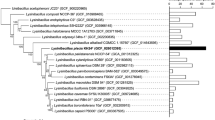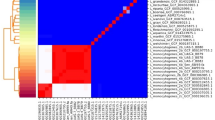Abstract
A bacterial strain was taxonomically characterised by means of a genomic approach comprising 16S rRNA gene sequence analysis, multilocus sequence analysis (MLSA), the DNA G+C content, whole genome analyses (ANI and GGDC) and phenotypic characterisation. The strain CAIM 1540T was isolated from a cultured oyster Crassostrea corteziensis in La Cruz, Sinaloa state, México. The isolate was found to be catalase and oxidase positive, cells were observed to be motile, O/129-sensitive and facultatively anaerobic. The almost-complete 16S rRNA gene sequence placed this strain within the genus Vibrio; the closest related species were found to be Vibrio aestivus, Vibrio marisflavi, Vibrio maritimus and Vibrio variabilis with similarity values of 99.02, 97.05, 96.70, and 96.59 % respectively. MLSA of four housekeeping genes (ftsZ, gapA, recA, and topA) was performed with the closely related species. A draft genome sequence of strain CAIM 1540T was obtained. The DNA G+C content of this strain was determined to be 43.7 mol%.The ANI values with V. aestivus were 89.6 % (ANIb), 90.6 % (ANIm) and a GGDC value of 39.5 ± 2.5 % was obtained; with V. marisflavi the genomic similarities were 71.5 % (ANIb), 85.5 % (ANIm) and 20.2 ± 2.3 % (GGDC); with V. maritimus 72.6 % (ANIb), 85.7 % (ANIm) and 22.0 ± 2.0 % (GGDC); and with V. variabilis 72.6 % (ANIb), 85.8 % (ANIm) and 21.6 ± 1.6 % (GGDC). These ANI and GGDC values are below the threshold for the delimitation of prokaryotic species, i.e. 95–96 and 70 %, respectively. Phenotypic characters also showed differences with the closest related species analysed. The results presented here support the description of a novel species, for which the name Vibrio mexicanus sp. nov. is proposed, with strain CAIM 1540T (= CECT 8828T, = DSM 100338T) as the type strain. In addition, we found that the recently described species Vibrio thalassae and Vibrio madracius might be a single species because the values of ANIb 95.8 %, ANIm 96.6 % and GGDC 70.2 ± 2.9 % are above the accepted species thresholds.


Similar content being viewed by others
Abbreviations
- ANI:
-
Average nucleotide identity
- GGDC:
-
Genome-to-genome distance calculator
- MLSA:
-
Multilocus sequence analysis
References
Amaral GRS, Dias GM, Wellington-Oguri M, Chimetto L, Campeão ME, Thompson FL, Thompson CC (2014) Genotype to phenotype: identification of diagnostic vibrio phenotypes using whole genome sequences. Int J Syst Evol Microbiol 64:357–365
Auch AF, von Jan M, Klenk H-P, Göker M (2010) Digital DNA–DNA hybridization for microbial species delineation by means of genome-to-genome sequence comparison. Stand Genom Sci 2:117–134
Austin B, Austin DA (1999) Bacterial fish pathogens: disease of farmed and wild fish, 3rd edn. Springer, Berlin
Cano-Gomez A, Goulden EF, Owens L, Høj L (2010) Vibrio owensii sp. nov., isolated from cultured crustaceans in Australia. FEMS Microbiol Lett 302:175–181
Chimetto LA, Cleenwerck I, Moreira APB, Brocchi M, Willems A, De Vos P, Thompson FL (2011) Vibrio variabilis sp. nov. and Vibrio maritimus sp. nov., isolated from Palythoa caribaeorum. Int J Syst Evol Microbiol 61:3009–3015
Dieguez AL, Beaz-Hidalgo R, Cleenwerck I, Balboa S, de Vos P, Romalde JL (2011) Vibrio atlanticus sp. nov. and Vibrio artabrorum sp. nov., isolated from the clams Ruditapes philippinarum and Ruditapes decussates. Int J Syst Evol Microbiol 61:2406–2411
Gomez-Gil B, RoqueA TurnbullJF, Tron-Mayen L (1998) Species of Vibrio isolated from hepatopancreas, hemolymph and digestive tract of a population of healthy juvenile Penaeus vannamei. Aquaculture 163:1–9
Gomez-Gil B, Thompson FL, Thompson CC, Swings J (2003) Vibrio rotiferianus sp. nov., isolated from cultures of the rotifer Brachionus plicatilis. Int J Syst Evol Microbiol 53:239–243
González-Castillo A, Balboa S, Romalde JL, Gomez-Gil B (2014) Vibrio crosai sp. nov., isolated from a cultured oyster Crassostrea gigas. Antonie Van Leeuwenhoek 106:457–463
Henz S, Huson D, Auch AF, Nieselt-Struwe K, Schuster S (2005) Whole-genomeprokaryotic phylogeny. Bioinformatics 21(10):2329–2335
Huson DH, Bryant D (2006) Application of phylogenetic networks in evolutionary studies. Mol Biol Evol 23(2):254–267
Kim OS, Cho YJ, Lee K, Yoon SH, Kim M, Na H, Park SC, Jeon YS, Lee JH, Yi H, Won S, Chun J (2012) Introducing EzTaxon-e: a prokaryotic 16S rRNA gene sequence database with phylotypes that represent uncultured species. Int J Syst Evol Microbiol 62:716–721
Lucena T, Ruvira MA, Arahal DR, Macián MC, Pujalte MJ (2012) Vibrio aestivus sp. nov. and Vibrio quintilis sp. nov., related to Marisflavi and Gazogenes clades, respectively. Syst Appl Microbiol 35:427–431
MacFaddin JF (1993) Pruebas bioquímicas para la identificación de bacterias de importancia clínica (translation by Médica Panamericana SA). Williams & Wilkins, Baltimore
Macián MC, Ludwig W, Aznar R, Grimont P, Schleifer KH, Garay E, Pujalte MJ (2001) Vibrio lentus sp. nov., isolated from Mediterranean oysters. Int J Syst Evol Microbiol 51:1449–1456
Meier-Kolthoff JP, Alexander AF, Hans-Peter K, Markus K (2013) Genome sequence-based species delimitation with confidence intervals and improved distance functions. BMC Bioinform 14:60
Moreira AP, Pereira N Jr, Thompson FL (2011) Usefulness of a real-time PCR platform for G+C content and DNA–DNA hybridization estimations in vibrios. Int J Syst Evol Microbiol 61:2379–2383
Moreira AP, Duytschaever G, Tonon LAC, Dias GM, Mesquita M, Cnockaert M, Francini-Filho RB, DeVos P, Thompson CC, Thompson FL (2014) Vibrio madracius sp. nov. isolated from Madracisdecactis (Scleractinia) in St. Peter & St. Paul Archipelago, Mid-Atlantic Ridge, Brazil. Curr Microbiol 69(4):405–411
Noguerola I, Blanch AR (2008) Identification of Vibrio spp. with a set of dichotomous keys. J Appl Microbiol 105:175–185
Oren A, Garrity GM (2014) List of new names and new combinations previously effectively, but not validly, published. Int J Syst Evol Microbiol 64:3603–3606
Oren A, Garrity GM (2015) List of new names and new combinations previously effectively, but not validly, published. Int J Syst Evol Microbiol 65:1–4
Pascual J, Macián MC, Arahal DR, Garay E, Pujalte MJ (2010) Multilocus sequence analysis of the central clade of the genus Vibrio by using the 16S rRNA, recA, pyrH, rpoD, gyrB, rctB and toxR genes. Int J Syst Evol Microbiol 60:154–165
Quail MA, Smith M, Coupland P, Otto TD, Harris SR, Connor TR, Bertoni A, Swerdlow HP, Gu Y (2012) A tale of three next generation sequencing platforms: comparison of Ion Torrent, Pacific Biosciences and IlluminaMiSeq sequencers. BMC Genom 13(1):341
Richter M, Rosselló-Móra R (2009) Shifting the genomic gold standard for the prokaryotic species definition. Proc Natl Acad Sci USA 106:19126–19131
Sasser M (1990) Identification of bacteria by gas chromatography of cellular fatty acids. Microbial ID Inc, Newark
Sawabe T, Kita-Tsukamoto K, Thompson FL (2007) Inferring the evolutionary history of vibrios by means of multilocus sequence analysis. J Bacteriol 189:7932–7936
Sawabe T, Ogura Y, Matsumura Y, Feng G, Rohul Amin AKM, Mino S, Nakagawa S, Sawabe T, Kumar R, Fukui Y, Satomi M, Matsushima R, Thompson FL, Gomez-Gil B, Christen R, Maruyama F, Kurokawa K, Hayashi T (2013) Updating the Vibrio clades defined by multilocus sequence phylogeny: proposal of eight new clades, and the description of Vibrio tritonius sp. nov. Front Microbiol 4:(414)1–14
Sheu S-Y, Jiang S-R, Chen CA, Wang JT, Chen WM (2011) Vibrio stylophorae sp. nov., isolated from the reef-building coral Stylophora pistillata. Int J Syst Evol Microbiol 61:2180–2185
Soto-Rodriguez SA, Gomez-Gil B, Lozano-Olvera R, Betancourt-Lozano M, Morales-Covarrubias MS (2015) Field and experimental evidence of Vibrio parahaemolyticus as the causative agent of acute hepatopancreatic necrosis disease of cultured shrimp (Litopenaeus vannamei) in Northwestern Mexico. Appl Environ Microbiol 81:1689–1699
Tamura K, Peterson D, Peterson N, Stecher G, Nei M, Kumar S (2011) MEGA5: molecular evolutionary genetics analysis using maximum likelihood, evolutionary distance, and maximum parsimony methods. Mol Biol Evol 28:2731–2739
Tarazona E, LucenaT Arahal DR, Macián MC, Ruvira MA, Pujalte MJ (2014) Multilocus sequence analysis of putative Vibrio mediterranei strains and description of Vibrio thalassae sp. nov. Syst Appl Microbiol 37:320–328
Thompson FL, Swings J (2006) Taxonomy of the vibrios. In: Thompson FL, Austin B, Swings J (eds) The biology of vibrios. American Society for Microbiology, Washington, pp 29–43
Thompson CC, Amaral GR, Campeão M, Edwards RA, Polz MF, Dutilh BE, Ussery DW, Sawabe T, Swings J, Thompson FL (2015) Microbial taxonomy in the post-genomic era: rebuilding from scratch? Arch Microbiol 197:359–370
Thompson CC, Chimetto L, Edwards RA, Swings J, Stackebrandt E, Thompson FL (2013) Microbial genomic taxonomy. BMC Genom 14:913
Tran L, Nunan L, Redman RM, Mohney LL, Pantoja CR, Fitzsimmons K, Lightner DV (2013) Determination of the infectious nature of the agent of acute hepatopancreatic necrosis syndrome affecting penaeid shrimp. Dis Aquat Organ 105:45–55
Wang H, Liu J, Wang Y, Zhang X-H (2011) Vibrio marisflavi sp. nov., isolated from sea water. Int J Syst Evol Microbiol 61:568–573
Yoshizawa S, Wada M, Yokota A, Kogure K (2010) Vibrio sagamiensis sp. nov., luminous marine bacteria isolated from sea water. J Gen Appl Microbiol 56:499–507
Acknowledgments
This work was partially funded by CONACYT project CB-2009-01 132328 and Grant AGL–2010–18438 from the Ministerio de Ciencia e Innovación (Spain).
Author information
Authors and Affiliations
Corresponding author
Electronic supplementary material
Below is the link to the electronic supplementary material.
Rights and permissions
About this article
Cite this article
González-Castillo, A., Enciso-Ibarrra, J., Bolán-Mejia, M.C. et al. Vibrio mexicanus sp. nov., isolated from a cultured oyster Crassostrea corteziensis . Antonie van Leeuwenhoek 108, 355–364 (2015). https://doi.org/10.1007/s10482-015-0488-1
Received:
Accepted:
Published:
Issue Date:
DOI: https://doi.org/10.1007/s10482-015-0488-1




